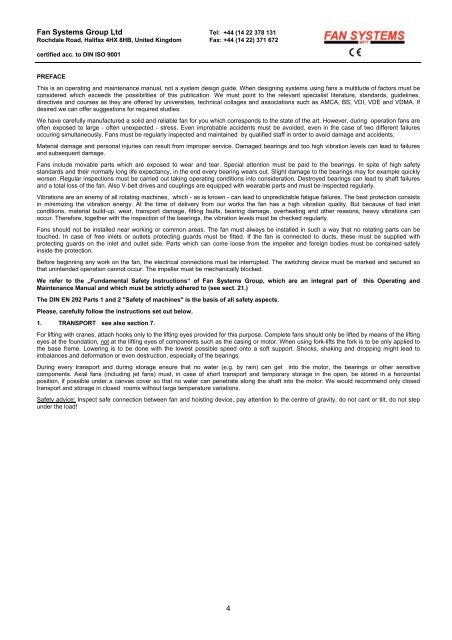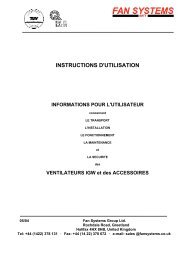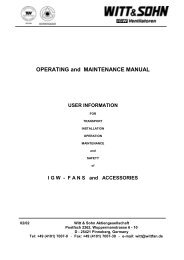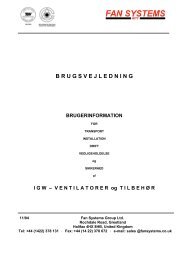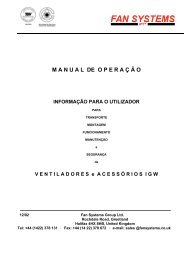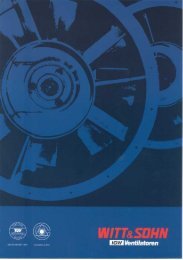Fan Systems Group Ltd Tel: +44 (14 22 378 131Rochdale Road, Halifax 4HX 8HB, United Kingdom Fax: +44 (14 22) 371 672certified acc. to DIN ISO 9001PREFACEThis is an operating <strong>and</strong> maintenance manual, not a system design guide. When designing systems using fans a multitude of factors must beconsidered which exceeds the possibilities of this publication. We must point to the relevant specialist literature, st<strong>and</strong>ards, guidelines,directives <strong>and</strong> courses as they are offered by universities, technical collages <strong>and</strong> associations such as AMCA, BS, VDI, VDE <strong>and</strong> VDMA. Ifdesired we can offer suggestions for required studies.We have carefully manufactured a solid <strong>and</strong> reliable fan for you which corresponds to the state of the art. However, during operation fans areoften exposed to large - often unexpected - stress. Even improbable accidents must be avoided, even in the case of two different failuresoccuring simultaneously. Fans must be regularly inspected <strong>and</strong> maintained by qualified staff in order to avoid damage <strong>and</strong> accidents.Material damage <strong>and</strong> personal injuries can result from improper service. Damaged bearings <strong>and</strong> too high vibration levels can lead to failures<strong>and</strong> subsequent damage.Fans include movable parts which are exposed to wear <strong>and</strong> tear. Special attention must be paid to the bearings. In spite of high safetyst<strong>and</strong>ards <strong>and</strong> their normally long life expectancy, in the end every bearing wears out. Slight damage to the bearings may for example quicklyworsen. Regular inspections must be carried out taking operating conditions into consideration. Destroyed bearings can lead to shaft failures<strong>and</strong> a total loss of the fan. Also V-belt drives <strong>and</strong> couplings are equipped with wearable parts <strong>and</strong> must be inspected regularly.Vibrations are an enemy of all rotating machines, which - as is known - can lead to unpredictable fatigue failures. The best protection consistsin minimizing the vibration energy. At the time of delivery from our works the fan has a high vibration quality. But because of bad inletconditions, material build-up, wear, transport damage, fitting faults, bearing damage, overheating <strong>and</strong> <strong>other</strong> reasons, heavy vibrations canoccur. Therefore, together with the inspection of the bearings, the vibration levels must be checked regularly.Fans should not be installed near working or common areas. The fan must always be installed in such a way that no rotating parts can betouched. In case of free inlets or outlets protecting guards must be fitted. If the fan is connected to ducts, these must be supplied withprotecting guards on the inlet <strong>and</strong> outlet side. Parts which can come loose from the impeller <strong>and</strong> foreign bodies must be contained safelyinside the protection.Before beginning any work on the fan, the electrical connections must be interrupted. The switching device must be marked <strong>and</strong> secured sothat unintended operation cannot occur. The impeller must be mechanically blocked.We refer to the „Fundamental Safety Instructions“ of Fan Systems Group, which are an integral part of this Operating <strong>and</strong>Maintenance Manual <strong>and</strong> which must be strictly adhered to (see sect. 21.)The DIN EN 292 Parts 1 <strong>and</strong> 2 "Safety of machines" is the basis of all safety aspects.Please, carefully follow the instructions set out below.1. TRANSPORT see also section 7.For lifting with cranes, attach hooks only to the lifting eyes provided for this purpose. Complete fans should only be lifted by means of the liftingeyes at the foundation, not at the lifting eyes of components such as the casing or motor. When using fork-lifts the fork is to be only applied tothe base frame. Lowering is to be done with the lowest possible speed onto a soft support. Shocks, shaking <strong>and</strong> dropping might lead toimbalances <strong>and</strong> deformation or even destruction, especially of the bearings.During every transport <strong>and</strong> during storage ensure that no water (e.g. by rain) can get into the motor, the bearings or <strong>other</strong> sensitivecomponents. <strong>Axial</strong> fans (including jet fans) must, in case of short transport <strong>and</strong> temporary storage in the open, be stored in a horizontalposition, if possible under a canvas cover so that no water can penetrate along the shaft into the motor. We would recommend only closedtransport <strong>and</strong> storage in closed rooms without large temperature variations.Safety advice: Inspect safe connection between fan <strong>and</strong> hoisting device, pay attention to the centre of gravity, do not cant or tilt, do not stepunder the load!4
Fan Systems Group Ltd Tel: +44 (14 22 378 131Rochdale Road, Halifax 4HX 8HB, United Kingdom Fax: +44 (14 22) 371 672certified acc. to DIN ISO 90012. INSTALLATION OF AXIAL AND CENTRIFUGAL FANS - GENERALWhen installing fans the instructions according to DIN 4024 (machine foundations.) parts 1 <strong>and</strong> 2 must be observed.Fans are only to be installed in the mounting position for which they were ordered <strong>and</strong> supplied (horizontal/vertical). Installation must be doneon a level foundation. Care must be taken that the fans are not mechanically deformed or submitted to unwanted forces in order to preventjamming or grinding of the impeller.When using vibration insulators, they must be placed so that an uniform compression is obtained. It may be necessary to insert shims. Whenthe fan is installed the insulators must not be canted, dragged over the floor or stressed on one side only. In that case the rubber or the springscould be damaged.Flexible connections must be installed to allow some fan movement, especially during the start-up. Equally, they must not be collapsed too faror misaligned so there are folds which could unduly impede the air flow, see also 13. Installation instructions for flexible connections. Incase of high pressure <strong>and</strong> danger of abrasion, guide rings (ducts) must be provided.The connection of the fan to the motor must be done according to the connection diagram in the terminal box <strong>and</strong> according to the instructionsof the motor maker. All motors are to be protected by means of motor protection devices. The connection must be carried out by licensedexpert staff taking into consideration the protection <strong>and</strong> safety instructions.3. DISMOUNTING - REFITTINGUnder certain circumstances, large fans must be dismounted into separate components, in order to enable transport through narrow accessdoors. Pages 16 shows detailed diagrams of st<strong>and</strong>ard fans to ease dismounting-refitting. This work should only be carried out by expert staff.Installation support devices should be available. All parts fitting together must be marked before being dismounted. Special attention must bepaid to the relationship between the parts. The interchange of parts can cause installation difficulties. The dismounting <strong>and</strong> installation of theimpeller can either be done by the use of an extraction disc or a clamping bush (see section 11.+12.).In case of a divided casing, remove screws of inlet grill <strong>and</strong> inlet bellmouth, take off the belt drive, <strong>and</strong> take off the upper part of thecasing after having removed the flange screws. Fix impeller at crane by means of fixing devices, but do not yet lift. Remove fixingscrews from bearings of the casing. Fix lifting devices at both ends of the shaft <strong>and</strong> connect to the crane. Carefully hoist the completeunit of impeller, shaft, bearing, inlet bellmouth out of the lower part of the casing. Further dismounting of the parts can be done aftersetting down the complete unit.A difference must be made between fans with a large access door <strong>and</strong> all <strong>other</strong> designs. At first, the power supply must be visibly <strong>and</strong>safely interrupted. For design B with a large bolted access, the bolts <strong>and</strong> the access door are removed. Then the impeller can either beloosened by means of the extraction disc or the taper-lock bush (see section 11. <strong>and</strong> 12.). Then the motor bolts can be removed.Lifting devices are to be used.For all <strong>other</strong> designs the fan must be separated from all connecting parts such as for example protective grills, silencers <strong>and</strong>, ducts,<strong>and</strong> must be placed on the floor with the impeller up. Then the impeller can be detached either with an extraction disc or taperlockbush. After that the motor can be unbolted. Lifting devices are to be used.4. START-UPGeneral Safety Instructions:Before engaging the fan, the casing <strong>and</strong> duct pipes must be investigated for foreign particles. Loose parts can be carried by the air flow <strong>and</strong>can lead to injuries. Attention must be paid to the installation of protection grills, belt protection <strong>and</strong> <strong>other</strong> safety features. No one may everst<strong>and</strong> in the air flow! The air pressure might be so strong that a human body <strong>and</strong> even heavy objects could be sucked into the fan or blownaway.The safety instructions for electrical equipment <strong>and</strong> of the electricity supply company must be observed at all times.The rotational direction of the fan is indicated by an arrow on the fan casing, the fan protection or the motor. This should be checked by brieflystarting the motor <strong>and</strong> observing the rotating parts. If it is wrong, the electrical leads must be reconnected. The amperage must be measured<strong>and</strong> compared to the nominal current of the motor. Centrifugal fans must be throttled appropriately, <strong>other</strong>wise the motor can be overloaded.The reverse is true for axial fans. With free outlet they absorb less power than when throttled.Before the rotational direction is reversed, the impeller must come to a complete st<strong>and</strong>still. The high moment of inertia can <strong>other</strong>wise lead todamage.Mechanical SafetySafety features must be installed to prevent moving parts being touched. If not an integral part of the fan they must be provided by theinstallation company. This is especially the case for inlets, outlet <strong>and</strong> access doors which must be secured on site.Systems with dampersDampers that can interrupt the airflow completely must be connected in such a manner that the fan is automatically stopped immediately afterclosing of the damper. Otherwise an excessive heating of the fan <strong>and</strong> excessive vibrations can occur.Fans operating in parallelWhen fans are operating in parallel ensure that the non-operating fans are not rotating in the opposite direction of their intended rotationaldirection. The start-up of a fan rotating in the wrong direction can <strong>other</strong>wise lead to overloading of the power supply <strong>and</strong> motor. Damage to theimpeller can also occur. Special care must be taken when carrying out maintenance work. The impeller has to be mechanically blocked beforestarting the maintenance work.5


